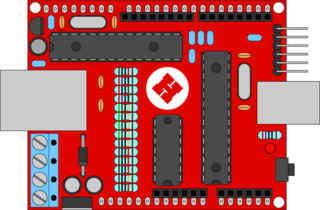Difference between revisions of "Project:Nanode"
Samthetechie (talk | contribs) |
Samthetechie (talk | contribs) (→Nanode) |
||
| Line 7: | Line 7: | ||
It allows you to develop web based sensor and control systems - giving you web access to six analogue sensor lines and six digital I/O lines. | It allows you to develop web based sensor and control systems - giving you web access to six analogue sensor lines and six digital I/O lines. | ||
It costs under £20 as an easy build it yourself kit. Nanode was designed with Hacking in mind. | It costs under £20 as an easy build it yourself kit. Nanode was designed with Hacking in mind. | ||
| + | |||
| + | ==How to get one?== | ||
| + | Here is a [http://nanode.eu/buy list of websites] where you can purchase a Nanode kit. | ||
==What can you do with it?== | ==What can you do with it?== | ||
Revision as of 18:38, 15 September 2011
Nanode
A 30 second pitch
Nanode is an open source Arduino-like board that has in-built web connectivity. It connects to a range of wireless, wired and ethernet interfaces. It allows you to develop web based sensor and control systems - giving you web access to six analogue sensor lines and six digital I/O lines. It costs under £20 as an easy build it yourself kit. Nanode was designed with Hacking in mind.
How to get one?
Here is a list of websites where you can purchase a Nanode kit.
What can you do with it?
Pachube
Anything you can do with an Arduino.
Where else to look
FAQ here's a list of Frequently Asked Questions about the Nanode
Registration - Add your newly built Nanode to the Register of Nanodes and Users
Documentation PCB Files, schematics and other useful pdf Documents
Building It - this shortcut takes you to the Pictorial Building Guide This is the definitive assembly guide in photos - which replaces more traditional parts lists, schematics and component insertion lists - please read this before you start soldering!
Applications - Here's a list of Applications currently under development on the Nanode
Nanode News - the latest happenings on the Nanode Project here
The previous version of this page Project:Nanode/scratch
